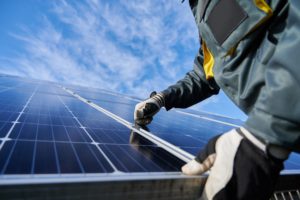South Africa is a hub for many mining operations, and yet granite isn’t one we often discuss. DLA Investments are changing this, providing a persistent and dependable supply of product, of surprisingly homogeneous quality.
Mining for granite and marble is considered one of the oldest industries in our history, with the organised, large-scale practise dating as far back as Ancient Egypt. The materials are still mined today, now sought the world over, with granite exporters found in China, Italy, India, Brazil, Canada, Germany, Sweden, Spain, the United States and of course, Africa.
Ancient Egypt utilised its granite to build vast and world-famous monuments that survived the sands of time: some of the most notable include Menkaure’s Pyramid, circa 26th century BC, which combined granite and limestone, the Great Pyramid of Giza’s famous sarcophagus fashioned of Red Aswan granite, and the granite capstone to Amenemhat III’s Black Pyramid, now found in the Egyptian Museum in Cairo. These examples were just some of the many uses of granite, which was mined using slave labour and carved to create columns, door lintels, window sills, wall and floor veneers and many other details adorning Ancient Egyptian architecture.
Whilst they undertook the oldest practise of this scale, Egypt was not the only country to heavily feature granite in early construction. The material became an integral part of Ancient Roman architecture, and even when their reserves thinned, they began to recycle and re-use the stone, implementing it for statues, houses of status, public buildings and temples. However, the world’s first entirely granite temple was construction in South India in the 11th Century AD, under the rule of the Chola Dynasty’s Rajaraja Chola I. The Brihadeeswarar Temple, built in Tanjore in 1010, was dedicated to Lord Shiva and was the tallest temple standing in South India at the time. The Gopuram alone – an ornate upper section to the temple’s shrine – is estimated to weight around 81 tonnes!
Whilst we no longer use granite so excessively, it still has a place in modern architecture. Its resilience and impressive appearance has kept the stone a popular choice for monuments and memorials, and also as a decorative tile and dimension stone for public and commercial buildings. However, its uses aren’t purely for pomp; granite is an extremely hardy stone, and as such, a highly practical one. Its weight and cost has seen modern materials replace it in some contexts, but it is still a popular choice for engineers when it comes to purchasing reliable surface plates. Used as a platform for precision work, it is essential for surface plates to be solid, resilient and perfectly smooth, the flat surface needing to be accurate up to 0.00001 inches. This is why granite remains a popular choice.
This is also where DLA Investments Granite Quarries (DLA) comes in. South Africa, and Africa as a continent, are well known for their mining, including but not limited to world-famous diamonds, gold and coal. However, since Egypt’s early claim to fame, Africa is not well known for granite. Whilst this may be the case, the continent certainly has granite to mine; DLA, based in South Africa and affiliated with Afrika National Granite Ltd, claim that their own supplies are plentiful. On top of this, they are currently the only quarry in South Africa that can produce blocks suitable for manufacturing into surface plates. They are able to provide first grade materials to surface plate manufacturers in blocks up to 15m in length, with a maximum of 70 tons per block. Whilst their granite is sold and exported for all purposes, its suitability for surface plates that is putting DLA on the granite map
Granite is a natural material, and as such, is subject to variations in colour and properties. Even so DLA are remarkably confident in their material’s consistency, boasting that it is extremely steady throughout. This makes their mines a desirable source, as the fewer variables in a supplier’s product, the easier it is for their clients to plan and work efficiently. In this case, the apparently unvarying stone is an “unfractured medium grained dark grey rock, consisting of phenocryst of grey and black minerals”, according to DLA’s official description. The company can provide this stone to its clients as gangsaw blocks of raw material cut to any size and dimension up to 10m.
DLA’s granite is sold both locally and on the export market. In fact, the division is pretty equally split, with around 50% of DLA’s market found within South Africa and the other 50% arranged through agents in Taiwan, North America and Eastern Europe. Today, DLA is run by Director Greta Del Sal, who took over the company in 2014. DLA currently has five quarries in operation, a remarkable four of which were opened since Greta took over leadership three years ago. The impact of this vast and gutsy expansion is already clear: production has doubled, with an even higher return likely in the years to come. To make the most of their new resources, DLA also recently invested heavily in new equipment from Barloworld. In particular, this equipment was intended for two of their four new mines, both of which only opened within the last year.
DLA are thinking ahead, considering the sustainability not only of their operations and delivery for their clients, but also the ongoing environmental sustainability of the land they mine. “Our quarry is designed to provide a constant supply of granite. We have plentiful reserves to sustain long term future delivery. We are also committed to operating within an environmentally sustainable framework by adopting responsible environmental care principles throughout the life cycle of our activities, including rehabilitation of the land.” This after-care for the land reflects a responsible attitude that extends to all areas of the company’s operations. Not only protecting their product and the environment, DLA are also careful to protect their workforce, stating that “management is active in ensuring a safe, healthy and financially secure environment for all of our employees.”
DLA’s conscientiousness does not stop there, but instead extends beyond their work practises and the consequences entirely, to include generous and empowering care for the local community. Working particularly closely with the people of Sonop, the site of DLA’s first quarry, the company has sponsored and been involved in many initiatives seeking to further the education of local children. For example, in partnership with non-profit organization The Better Living Foundation, DLA sponsored educational seminars on drug awareness for the students at Sonop Primary School. Additionally, in partnership with the One Book One Learner project, DLA delivered workshops to both the teachers and primary school students at the school after they became aware that many students were struggling with learning maths. The company had this to say about the initiative: “This unique project has yielded great results across South Africa. Students are now taught that maths is a language like any other, and they were shown how to use their personal maths dictionaries so that they can understand all the concepts and terminology they need in order to do well.”
The workshops were an incredible success, not only on the day, but in the ongoing benefits they yielded for students: “For the Grade 7 learners, 92% improved their results by an average of 26%, which is exceptional.” The results show a genuine difference made in the lives of these children – in other words, the future employees and entrepreneurs of the area. “We wanted to contribute to our local community and give the children all the gains possible. Through education, we are doing our part to revitalize our nation by empowering our youth with knowledge.” This support not only contributes to a more secure future for these children, but by extension, the country and continent as a whole. As DLA continues to mine its reliable product, they will continue to do their part in supporting the Africa of tomorrow, in the hopes it can that it can someday soon be as solid and consistent as the granite they export.







